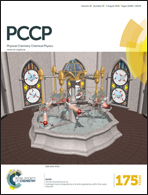Molecular mechanics of the cooperative adsorption of a Pro-Hyp-Gly tripeptide on a hydroxylated rutile TiO2(110) surface mediated by calcium ions
Abstract
The interaction of amino acids with inorganic materials at interfaces plays an important role in enhancing the biocompatibility of titanium-based alloys. The adsorption of a tripeptide, i.e. Pro-Hyp-Gly, on the hydroxylated rutile TiO2(110) surface was investigated by the MD simulations. The changes in free energy during the adsorption of both the tripeptide and calcium ions were calculated by using the PMF method in order to obtain the adsorption strength. The results suggested that the adsorption of the tripeptide on the TiO2 surface through the carboxyl groups in glycine residues can be more stable compared with other binding conformations. Special attention was focused on the cooperative adsorption of the tripeptide with the assistance of calcium ions. Calcium ions preferred to absorb at the tetradentate or monodentate sites on the negatively charged TiO2 surface. As a result of the strong attraction between the carboxyl group and calcium ions, the tripeptide can be pulled down to the surface by following the trajectory of the calcium ions, forming an indirect interaction with a sandwich structure of peptide–cation–TiO2. However, this indirect interaction could eventually transform to the direct adsorption of the tripeptide on the TiO2 surface with higher binding energy. The results may help to interpret the adsorption of peptides on inorganic materials in aqueous solution with ions.


 Please wait while we load your content...
Please wait while we load your content...